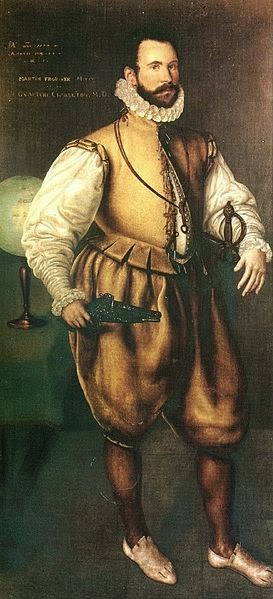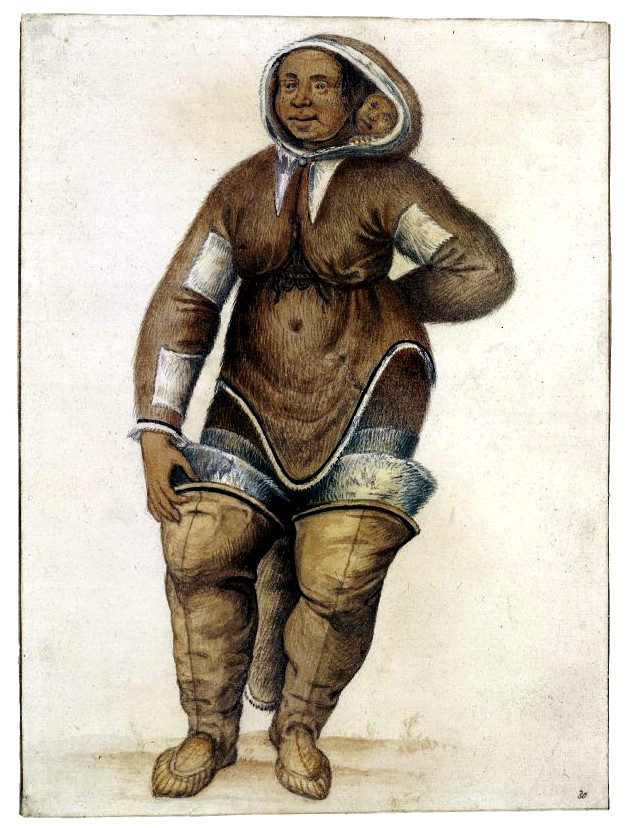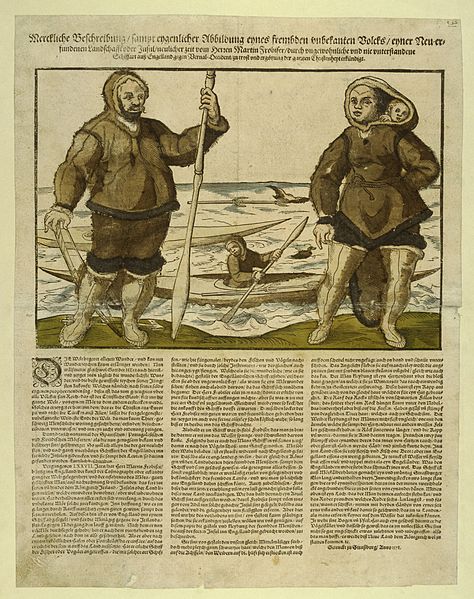
Martin Frobisher (ca 1539 – 1594)
On November 22, 1594, English seaman and explorer Sir Martin Frobisher passed away. He is best known for his three voyages to the New World in search for the Northwest Passage.
Early Years
Frobisher was born around 1535, the sixteenth child of his parents, came from an old Yorkshire family who had lived in the municipality of Normanton in the West Riding of Yorkshire since the mid-14th century. After the early death of his father Bernhard Frobisher, his mother sent him to London to her brother Sir John York to take care of his upbringing. In 1550, when Martin was 15 years old, at the behest of his uncle, he began training as a seafarer, which he completed as captain in 1565. He married in 1559.
Martin Frobisher’s First Journeys
During his training, Frobisher took part in several trade trips to Guinea, during which he was temporarily captured in Portugal (nine months at Elmina Castle). After his return to England he gave himself up to a lawless life as a privateer due to his bad experiences. Within a few years he was considered one of the most daring and unscrupulous pirates of the English Channel and one of the most wanted men of his time. After a changeable career as a buccaneer, Frobisher entered the service of the English queen around 1571 and from then on patrolled the Irish Sea legally to bring up French and Portuguese ships.
The Muscovy Company
In the 1560s, he decided to undertake a journey searching for the Northwest Passage in order to establish a trade route to India and China. Unfortunately, it took more than 5 years to gather the needed funding. In 1576, Frobisher met an English merchant consortium called the Muscovy Company that already sent teams to find the Northeast Passage. The company’s director Michael Lok then helped the adventurer to raise the badly needed money. They managed to gather a total of three ships, the Gabriel and Michael, each weighing about 25 tons and another lighter ship. The crew consisted of about 35 men and set sail on 7 June, 1576 . Unfortunately, all ships but the Gabriel got lost due to heavy storms. However, the Gabriel sighted the coast of Labrador very soon. The mouth of Frobisher Bay was reach just shortly after followed by heavy ice storms. Frobisher decided to sail towards the west and made a stop at Baffin Island in 1576. Having met a couple of local Inuits, they made an agreement that the natives would guide the crew through the region. Frobisher gathered a team of five men who were supposed to discover the near region. Unfortunately, the men never returned. The remaining crew sailed back home and even though the journey was in general regarded as fruitless, Frobisher began immediately to raise funds for another travel.

Painting of the abducted Inuit woman with her child from 1577, made during Frobisher’s second expedition
In Search of the Northwest Passage
Already one year later, specific plans for the next journey were made. Martin Frobisher was appointed high admiral “of all lands and waters that might be discovered by him”. This crew was much bigger. Around 150 men, being miners, soldiers and refiners, sailed towards Frobisher Bay and reached it in July of the same year. The crew collected big loads of ore first and attempts were made to rescue the lost five men from the last mission, but it was hopeless. The crew returned to England in 1577 and was thanked by the queen herself.

Report on Frobisher’s Third Voyage
The Third Voyage
When he returned from his expedition in the autumn of 1577 with 200 tons of “gold ore” and three Eskimos, they were all enthusiastic and granted him generous funds for a third trip. In the early summer of 1578 Frobisher set off again with a fleet of 15 ships. This time not with the aim to search for the Northwest Passage, but exclusively to mine “gold ore” and to establish a permanent colony on site. After a largely unsuccessful journey, Frobisher returned home to England in the autumn of 1578, where in the meantime it had turned out that the “gold ore” he had recovered during his second journey was in fact pyrite and had no value at all. Financially ruined and involved in numerous disputes with former business partners and financiers, Frobisher accepted a position as captain on a royal ship in 1580 and fought the Spaniards who supported the Irish insurgents at the time. In 1581 Frobisher attempted to set up a fourth expedition around the Cape of Good Hope to Asia in search of clues to a northern route to Europe, but these efforts failed.
Further Campaigns
In 1585 he took part in the West Indian Campaign, where he served as Vice Admiral under Francis Drake and commanded the Primrose.[5] During this campaign he conquered the Spanish fort near Cartagena. In 1588, in the battle against the Spanish Armada, he received command of the Triumph, the largest English galleon, with which he sunk four Spanish galleasses, whereupon he was knighted. In 1591 Frobisher married his second wife, a daughter of Lord Wentworth, which made him the owner of some estates in Yorkshire and Nottinghamshire. However, country life could only hold him for a short time and the following year he took part in a raid of Sir Walter Raleigh on the Spanish coast, from where he returned home with rich prey; on this expedition he lost an eye due to an accident. In November 1594, Frobisher was wounded fighting the Spaniards at the head of a stormy troop at Fort Crozon near Brest. He was taken to Plymouth, where he died on 22 November 1594 due to a medical malpractice.
As Martin Frobisher was not the only one trying to find the Northwest Passage, you may be interested in who else traveled his way and what they accomplished.
James P. Delgado, The Quest for the Northwest Passage [8]
References and Further Reading:
- [1] The three voyages of Martin Frobisher in search of a passage to Cathay and India by the north-west, A.D. 1576-8: From the original 1578 text of George Best, together with numerous other versions, additions etc., now edited, with preface, introduction, notes, appendixes and bibliography
- [2] Short Biography of Frobisher
- [3] Frobisher at the Elizabethan Era Website
- [4] Narratives of voyages towards the north-west, in search of a passage to cathay and india, 1496 to 1631
- [5] Sir Francis Drake’s discovery of Nova Albion, SciHi Blog
- [6] The Virgin Queen – Elizabeth I. SciHi Blog
- [7] Martin Frobisher at Wikidata
- [8] James P. Delgado, The Quest for the Northwest Passage, U.S. Department of Commerce @ youtube
- [9] Thomas Rundall: Narratives of voyages towards the north-west, in search of a passage to cathay and india, 1496 to 1631. The Hakluyt Society, London 1848
- [10] Lemercier-Goddard, Sophie: George Best’s Arctic Mirrors. A True Discourse of the Late Voyages of Discoverie… of Martin Frobisher (1578), in: Frédéric Regard (Ed.): The Quest for the Northwest Passage (Band 19), Routledge, London 2013, pp 55 – 70
- [11] McGhee, Robert: The Arctic Voyages of Martin Frobisher. An Elizabethan Adventure, University of Washington Press, Seattle/London 2001
- [12] Timeline of 16th century Explorers via Wikidata and DBpedia





